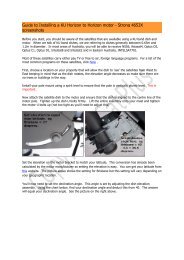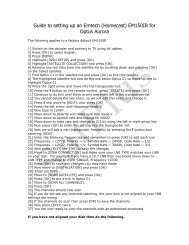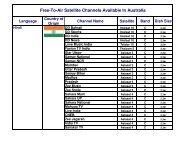What's channels are available on satellite? - SatPlus
What's channels are available on satellite? - SatPlus
What's channels are available on satellite? - SatPlus
You also want an ePaper? Increase the reach of your titles
YUMPU automatically turns print PDFs into web optimized ePapers that Google loves.
<str<strong>on</strong>g>What's</str<strong>on</strong>g> <str<strong>on</strong>g>channels</str<strong>on</strong>g> <str<strong>on</strong>g>are</str<strong>on</strong>g> <str<strong>on</strong>g>available</str<strong>on</strong>g> <strong>on</strong> <strong>satellite</strong>?<br />
There <str<strong>on</strong>g>are</str<strong>on</strong>g> basically 2 types of systems that <str<strong>on</strong>g>are</str<strong>on</strong>g> <str<strong>on</strong>g>available</str<strong>on</strong>g> for recepti<strong>on</strong> of Satellite TV <str<strong>on</strong>g>channels</str<strong>on</strong>g>.<br />
C Band systems.<br />
A C band system utilises a larger dish generally around 1.8 - 3.0 metres in diameter. This type of<br />
system will enable you to watch (mostly) foreign language <str<strong>on</strong>g>channels</str<strong>on</strong>g> from the Asia Pacific regi<strong>on</strong>s.<br />
Although there <str<strong>on</strong>g>are</str<strong>on</strong>g> a limited few English speaking <str<strong>on</strong>g>channels</str<strong>on</strong>g>, most people purchase <strong>on</strong>e of these<br />
systems in order to view programs in a specific language. If you purchase a fixed dish, this will be<br />
locked <strong>on</strong>to a chosen <strong>satellite</strong> and you will <strong>on</strong>ly be able to view programs from that particular<br />
<strong>satellite</strong>. If you motorise your dish, when correctly aligned, you will be able to view <str<strong>on</strong>g>channels</str<strong>on</strong>g> from all<br />
of the <str<strong>on</strong>g>available</str<strong>on</strong>g> <strong>satellite</strong>s that transmit C band programs. We have listed most of the more comm<strong>on</strong><br />
<str<strong>on</strong>g>channels</str<strong>on</strong>g> that <str<strong>on</strong>g>are</str<strong>on</strong>g> free to air below (no subscripti<strong>on</strong> required). The most comm<strong>on</strong> <strong>satellite</strong>s <str<strong>on</strong>g>available</str<strong>on</strong>g><br />
from within Australia <str<strong>on</strong>g>are</str<strong>on</strong>g>:<br />
Telstar 10 - This <strong>satellite</strong> carries several Arabic Dubai <str<strong>on</strong>g>channels</str<strong>on</strong>g>, ERT and RIK SAT Greek programs<br />
and a few others. It is low <strong>on</strong> the horiz<strong>on</strong> from the East coast of Australia and is difficult to receive in<br />
Brisbane but can be received in Sydney, Melbourne and other Western states. Telstar 10 <strong>on</strong> Lyngsat.<br />
Thaicom 5 - The most comm<strong>on</strong> programs <strong>on</strong> this <strong>satellite</strong> <str<strong>on</strong>g>are</str<strong>on</strong>g> Korean Central TV and Vietnamese<br />
VTV4. We can <strong>on</strong>ly pick up the Global beams <strong>on</strong> this <strong>satellite</strong>. Click here for Lyngsat.<br />
Insat2E - Insat2E carries mainly Indian TV programs. These <str<strong>on</strong>g>are</str<strong>on</strong>g> Asianet, Jeevan TV, Asianet News,<br />
Asianet Plus, Asianet Suvarna, Amrita TV, NE Hi Fi, Raj Musix, TV5, Win TV, Makkal TV, Tamilan TV,<br />
Kairali Channel, Kairali People, Kairali We, Manorama News Channel, Mega TV, Subhavaartha TV,<br />
Kalaignar TV, ETV Urdu. We can reliably receive the wide <str<strong>on</strong>g>are</str<strong>on</strong>g>a beams in Australia although it is<br />
reported that z<strong>on</strong>e beams can be picked up in NT and NW Western Australia. Insat Lyngsat info<br />
here.<br />
Asiasat5 - This <strong>satellite</strong> broadcasts quite a range of Arabic <str<strong>on</strong>g>channels</str<strong>on</strong>g> such as Emirates Channel, Al<br />
Nile, Press TV, Alalam News Channel, Alkass, Kuwait Space Channel, Jame Jam TV Network 3, Syria<br />
Satellite Channel, Yemen TV, Abu Dhabi TV Europe, Oman TV, Saudi Arabian TV 1, Qatar TV, Sudan<br />
TV, Sharjah TV, Jamahirya TV, Saudi Arabian TV2, Al Jazeera TV. There is also RTR Planeta which is<br />
Russian TV, Rai Internati<strong>on</strong>al 3 (Italian), TVE Internati<strong>on</strong>al Spanish, RTP (Portuguese) and<br />
Cubavisi<strong>on</strong>. Lyngsat here.<br />
Asiasat3s - This popular <strong>satellite</strong> broadcasts Now TV, Bloomberg, TV5 (French), DW TV (German),<br />
Star Utsav (Urdu), several Sahara Hindi Channels, several PTV Pakistan TV <str<strong>on</strong>g>channels</str<strong>on</strong>g>, Zee Music and<br />
Zee Smile (Indian) and quite a few Chinese <str<strong>on</strong>g>channels</str<strong>on</strong>g>. Lyngsat here.<br />
PalapaD - Looking for Ind<strong>on</strong>esian programs? then this is the <strong>satellite</strong> to point to. Several<br />
Ind<strong>on</strong>esian <str<strong>on</strong>g>channels</str<strong>on</strong>g> can be received from Australia including TVRI Nati<strong>on</strong>al, RCTI, Bali TV, SCTV,<br />
Global TV, Metro TV and TV Anak Spaceto<strong>on</strong>. We can <strong>on</strong>ly receive the Asean Plus beams. Lyngsat<br />
here.<br />
ChinaSat6B - This <strong>satellite</strong> is the best for Chinese programming. Too many to list. More info at the<br />
Lyngsat site.<br />
Asiasat4 - Nothing much here at the moment.<br />
Apstar 6 - Used to be loaded with Chinese <str<strong>on</strong>g>channels</str<strong>on</strong>g> but they have all now moved to Chinasat6B.<br />
Telstar18 - Not much here. Lyngsat link.<br />
Intelsat8 - MTV China, Australia Network Asia, TVBS <str<strong>on</strong>g>channels</str<strong>on</strong>g> (Chinese), BBC World Japan, NHK<br />
World TV Japan. Lyngsat link.<br />
Intelsat5 - Australia Network Pacific, BBC World and that's about it. Lyngsat here.<br />
Most of the free to air <str<strong>on</strong>g>channels</str<strong>on</strong>g> <str<strong>on</strong>g>are</str<strong>on</strong>g> broadcast <strong>on</strong> C band while some <str<strong>on</strong>g>are</str<strong>on</strong>g> broadcast <strong>on</strong> KU band. C-<br />
band range of frequencies extends from 3.4 GHz to 6.7 GHz. As the signal strength is relatively weak,<br />
larger antennas <str<strong>on</strong>g>are</str<strong>on</strong>g> needed to receive the signal. Most of Australia can receive C band broadcasts<br />
using a 2.3 metre mesh dish or 1.8metre solid.
KU Band Systems.<br />
A KU Band dish system receives local str<strong>on</strong>g beams that <str<strong>on</strong>g>are</str<strong>on</strong>g> focused into (in our case) Australia and<br />
due to the strength and frequency of the signal, a small dish will suffice. Sizes in the range of 65cm<br />
to 1.2 metre <str<strong>on</strong>g>are</str<strong>on</strong>g> comm<strong>on</strong>. There is not a huge choice of programming that is free to air but still<br />
worth listing. There <str<strong>on</strong>g>are</str<strong>on</strong>g> also several Pay TV providers in Australia <strong>on</strong> different <strong>satellite</strong>s so these have<br />
been listed as well.<br />
Optus D2 (replaces B3's locati<strong>on</strong>) - This <strong>satellite</strong> offers the most choice of free to air programming<br />
<strong>on</strong> a KU band small dish. Programs <str<strong>on</strong>g>available</str<strong>on</strong>g> <str<strong>on</strong>g>are</str<strong>on</strong>g>: Kurdsat, Oman and Abu Dhabi (Arabic), TVR<br />
Internati<strong>on</strong>al (Romanian), Russia Today (English), ERT (Greek), Thai TV Global, Duna TV<br />
(Hungarian), TRT Internati<strong>on</strong>al (Turkish), BVN (Dutch). There is also a range of religious TV<br />
programming <strong>on</strong> this <strong>satellite</strong> including: EWTN, Hope Channel, 3ABN, The Church Channel,<br />
Inspirati<strong>on</strong> Network, Daystar, TBN, JCTV, God TV and Smile of a Child. More info <strong>on</strong> the Lyngsat<br />
website.<br />
Optus C1 - This <strong>satellite</strong> broadcasts all of the pay TV <str<strong>on</strong>g>channels</str<strong>on</strong>g> for Foxtel and Austar which <str<strong>on</strong>g>are</str<strong>on</strong>g><br />
scrambled and require subscripti<strong>on</strong>. It also carries the new VAST free to air <strong>satellite</strong> service which<br />
offers those living in poor TV recepti<strong>on</strong> <str<strong>on</strong>g>are</str<strong>on</strong>g>as as well as travellers, access to the full range of digital<br />
TV <str<strong>on</strong>g>channels</str<strong>on</strong>g>. Info <strong>on</strong> the Lyngsat site.<br />
Optus D1 - This <strong>satellite</strong> replaced the Optus B1 <strong>satellite</strong> towards the latter half of 2007. It is used<br />
for distributi<strong>on</strong> of ABC and SBS digital terrestrial services throughout Australia as well as the New<br />
Zealand pay TV <str<strong>on</strong>g>channels</str<strong>on</strong>g> and New Zealand's freeview TV service (New Zealand programs cannot be<br />
picked up in Australia). Southern Cross Broadcasting is quite often <strong>on</strong> this <strong>satellite</strong> as well. No<br />
smartcard required for access either. If you're looking for a way to get better recepti<strong>on</strong> of ABC,<br />
ABC2, SBS and SBS2 in widescreen format then this is the <strong>satellite</strong> to go for. Lyngsat site here.<br />
Intelsat8 - Formerly called Pas8, this <strong>satellite</strong> now broadcast the SelecTV line up of Pay TV<br />
<str<strong>on</strong>g>channels</str<strong>on</strong>g>. Well priced and with movies, if you've had enough of the 'other' pay TV providers then<br />
perhaps SelecTV could be the answer. Lyngsat here.<br />
Ku-band is generally c<strong>on</strong>sidered to extend from 12 to 18 GHz. However, <strong>satellite</strong> communicati<strong>on</strong><br />
engineers use the term "Ku-band" to refer to an extended frequency range from 10.7 GHz to 18.4<br />
GHz. This frequency range actually includes part of the X-band (8-12 GHz) and part of the K-band<br />
(18-27 GHz). Almost all Ku-band <strong>satellite</strong> systems employ at least part of the X-band frequency range<br />
(10.7-12 GHz). Smaller 65-120 cm dishes <str<strong>on</strong>g>are</str<strong>on</strong>g> sufficient to receive Ku band in all of Australia.







